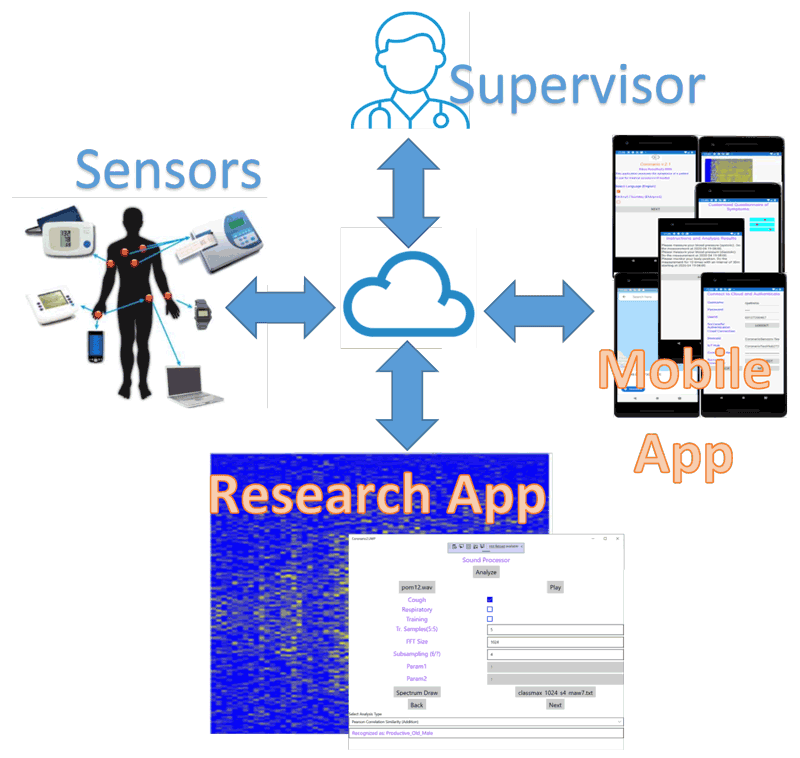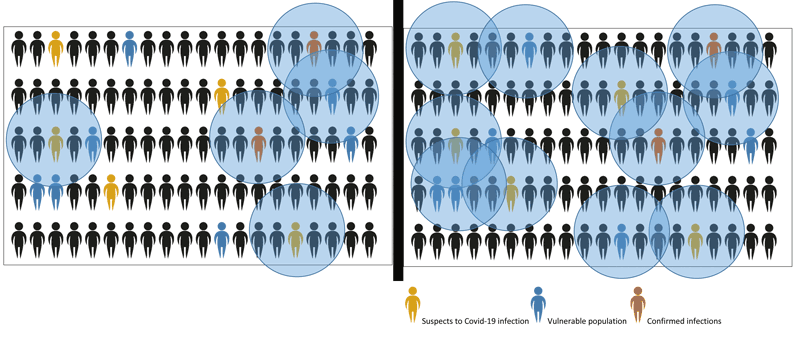by Nikos Petrellis (University of the Peloponnese)
Coronario is a multi-purpose platform that supports symptom tracking, social distancing and tracing, and experimentation with the reactions of the COVID-19 virus. Coronario users can be patients, medical practitioners and researchers. A major aim of the platform is to facilitate early detection and tracing of infected individuals as well as their behaviour based on localization and sensor indications.
Remote tracking of COVID-19 symptoms is essential to control the spread of the virus. Recent research indicates that symptoms such as coughing can reveal a COVID-19 infection with a greater than 97% success rate [L1]. Medical practitioners in primary healthcare units have to remotely assess the condition of people who are potentially infected by COVID-19, based on vague descriptions of symptoms. Missing or exaggerated information, rush and congestion, rapidly changing medical protocols and the subjective opinion of a doctor can lead to an inaccurate initial diagnosis. Reliable molecular tests (polymerase chain reaction-PCR) and immunoassays are used to confirm a COVID-19 infection. Less expensive, but also less reliable, rapid tests have recently been employed to keep up with the large numbers of people that need regular monitoring. Rapid tests are also useful for screening travellers and sampling asymptomatic people. These tests lead to a good statistical assessment of the pandemic, but symptom tracking and social distancing are still valuable weapons. Distinguishing the symptoms of COVID-19 from other infections is particularly useful in seasons other than summer, when colds and the flu are also common.
The Coronario platform was developed at the University of Peloponnese, Patras, Greece. Its primary goal was to reduce the traffic to the call centres of primary healthcare units during the first outbreak of COVID-19. Several approaches were proposed that involved smart phone apps or web pages that advise users about how to treat their symptoms [1]. In addition to symptom tracking, Coronario was equipped with additional functionality to support social distancing [2][3] and research, with the incorporation of advanced signal processing techniques and geolocation. The accuracy of the diagnosis is further improved through the use of data from external medical and environmental sensors (temperature, SPO2, blood pressure, glucose meter, galvanic skin sensors (GSS), etc). Some of these sensors (body position and respiratory sensors, GSS, etc) can also provide indications about the habits of the users. For example, body position can be used to estimate how long the user stays in bed or in conjunction with the respiratory sensor it can reveal how much exercise he gets.
COVID-19 diagnosis rules change regularly, and this was especially pronounced during the first outbreak, due to the unknown nature of this virus. For example, difficulty is smelling or tasting was added later as a typical COVID-19 symptom. Thus, dynamic medical protocol adaptation was one of the major features that the Coronario platform had to support. The medical protocols are used in Coronario to determine the alert rules, the sampling strategy of the various sensors and the list of questions that the user needs to answer. The alert rules are defined as conditions with associated actions. If the sensor indications and the information given by the user make a condition true, an alert action takes place. Sensor sampling strategy is a schedule of the medical tests the user should undertake using the available sensors listed in the previous paragraph. The dynamic adoption of new medical protocols makes Coronario useful in a range of circumstances. One target group includes people who are suspected to have COVID-19 but have not yet been tested. It is also useful for monitoring the condition of recovered patients once they have returned home from hospital. People who are more likely to be vulnerable to COVID-19, such as those with kidney failure or cancer. These patients can also benefit from the platform by using this tool before they visit their hemodialysis or oncology centre, respectively, in order to make sure that they won’t spread COVID19 once their symptoms indicate that they may have been infected.
The data gathered by the smart phone app and the sensor infrastructure can be stored in the cloud. The authorised supervising doctor accesses this information, approves a diagnosis and suggests actions through a desktop application. The doctor is also responsible for determining the appropriate medical protocol. In addition to the aforementioned Coronario components (user mobile app, sensor infrastructure, cloud, supervisor app), the platform is also equipped with an application for researchers, as shown in Figure 1. In this version of the Coronario platform, the sound of a cough or respiration can be analyzed and classified using an extensible set of pattern matching algorithms.

Figure 1: The Coronario platform consists of: (a) a mobile app to acquire patient input, geolocation, cough/respiratory sounds, and to allow communication between supervisor and patient, (b) medical and environmental sensor infrastructure, (c) cloud storage, (d) a supervisor app, and (e) a research app for experimentation.
Social distancing and tracing are also supported by the smart phone’s GPS (Global Positioning System), which determines the user’s location. A web page with up-to-date information is accessed and the history of COVID-19 cases for the region is retrieved. The user is informed about the number of registered incidents in the local area. A detailed report about the evolution of COVID-19 incidents over recent days and their regional dispersion can encourage the user to maintain social distancing. Furthermore, preserving the GPS records of the user’s phone for, say, 14 days, can enable contact tracing if the user is diagnosed with COVID-19.
Figure 2 shows how Coronario can assist in tracing COVID-19. Currently, some of the symptomatic (suspects) and asymptomatic patients will undergo a PCR test (Figure 2a). Many of the symptomatic patients will not recognise their symptoms as COVID-19 and will not perform a molecular test. Members of the vulnerable population will not do a COVID-19 test unless they have a reason to do so, such as developing symptoms or moving to a new medical centre. Coronario is expected to be used primarily by symptomatic individuals, urging them to proceed to a PCR test if necessary. Vulnerable people with weak immune systems can also be monitored systematically. The coverage of the infected people, and consequently the appropriate tracing, can be more efficient using a platform like Coronario.

Figure 2: Coronario allows more individuals and groups to be monitored. Suspects with severe symptoms and an indicative sample of asymptomatic individuals are currently being tested: (a, left) Vulnerable people and all suspects, even with milder symptoms, are added to the population that is systematically monitored using Coronario; (b, right) Being able to identify more infected people leads to more efficient tracing and social distancing policies.
The app adheres to the General Data Protection Regulation (GDPR) guidelines: all users are authenticated and data are encrypted and exchanged anonymously. Most of the data processing is performed locally in the user’s mobile application or by the medical sensor controller. Only the necessary information is uploaded to the cloud and is deleted as soon as it has been accessed by the authorised supervisor. The data used for scientific research (e.g., cough sounds) are anonymous, and used only after user consent.
The next step is to test and improve the platform in a hospital environment. Even if a vaccine or treatment for COVID-19 is developed, Coronario will still be useful for tracking any similar viruses.
Link:
[L1] https://www.sciencealert.com/ai-cough-analysis-could-detect-covid-19-even-if-you-re-asymptomatic
References:
[1] R. Abbas, K. Michael: “COVID-19 Contact Trace App Deployments: Learnings from Australia and Singapore,” IEEE Consumer Electronics Magazine, doi: 10.1109/MCE.2020.3002490.
[2] K. Michael, R. Abbas: “Getting Behind COVID-19 Contact Trace Apps: The Google-Apple Partnership”, IEEE Consumer Electronics Magazine, doi: 10.1109/MCE.2020.3002492.
[3] E. Hernández-Orallo, et al.: “Evaluating How Smartphone Contact Tracing Technology Can Reduce the Spread of Infectious Diseases: The Case of COVID-19”,” IEEE Access, vol. 8, pp. 99083-99097, 2020, doi: 10.1109/ACCESS.2020.2998042.
Please contact:
Nikos Petrellis, University of the Peloponnese, Greece











